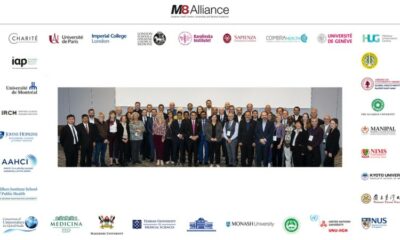Education
Fred DuVal: University Leadership as a Critical Resource for Climate Change Research and Life-Saving Solutions
While our nation’s political leadership debates the severity and causes – and even the vocabulary – of our warming climate, there’s one thing everyone can agree on: weather patterns are changing.
Over the past few decades, parts of the planet have become warmer, hurricanes have become more frequent and intense, drought has become more widespread, and severe wildfires – and the wildfire season – have become remarkably worse.
These startling conditions may sometimes seem unmanageable, though there are many things we can do to address the changing weather. These generally fall into three buckets: 1) causes and mitigation, 2) adaptation, and 3) post-recovery hardening.
So, how exactly do we reduce the risk of harm? How do we manage its inevitable occurrence?
And how do we recover from it in ways that will reduce recurring harm?
Universities play a prominent role in areas not only concerning the safety of their students and the protection of their campuses, but also as partners with local communities. And there are many students who can learn as they do.
First, it is essential for research universities to do what they do best: provide good science. Universities must stay nonpolitical but also provide facts and data that policymakers can trust.
Second, universities are in the solutions business. The best research in the world on climate change mitigation is being conducted in our labs, whether it concerns cleaner fuels, cogeneration, battery storage, biofuels, or countless other strategies for reducing the effects of carbon use.
This includes but is not limited to:
- Arizona State University’s Center for Bioenergy, which is making impressive breakthroughs regarding algae’s use as biofuel.
- Northern Arizona University, where scientists are mapping the movement and habits of bark beetles that are eating and killing our forests while turning trees into wildfire fuel.
- The NAU School of Forestry, which is leading the Four Forests Restoration Initiative – the largest forest restoration initiative in the United States on federal lands.
- The University of Arizona and the Arizona Institute for Resilience, which are now offering 15 discrete programs to support local communities on the issue of heat mitigation.
Additionally, all three Arizona universities are pioneering new irrigation and approaches to crop water to help reduce the use of this precious resource.
Universities are looking for long-term solutions. Arizona State University’s School of Sustainability is converting waste plastics into furniture and building materials. ASU’s Center for a Carbon Neutral Economy is a federally funded ‘hydrogen hub’ seeking to make this clean water-based fuel viable at scale and exploring ways to protect the power grid from weather risks, such as extreme heat and drought.
Universities are in the public service business. Water is scarce in Arizona, and we lose valuable water every summer monsoon season (when rain runoff disappears into the ground). Arizona scientists are now mapping these runoff patterns and bringing to the public sector hydrology and aquifer mapping, which, ideally, will enable policymakers to invest in water redirection strategies.
Much of this is about assuring a viable private-sector response. To that end, Arizona State University has built the Southwest Sustainability Innovation Engine, a start-up fund with 150 partners who, to date, have invested in eight sustainability-oriented startups.
Most importantly, universities are involved in the student education business. Arizona students are engaged in every aspect of university research and community service. For instance, students at Northern Arizona University have created a Rural Water Toolkit, a comprehensive guide bringing the best mitigation and resilience strategies to small towns without resources to conduct their own research. From this came the nation’s first Climate Resilience Corps, an AmeriCorps component enabling students to share their research with non-profits, cities, and tribal nations.
What’s more: all three Arizona universities are doing pioneering research into ways to mitigate the incidence of Valley Fever, which manifests in extreme weather conditions.
Activities of this kind are happening at most universities across the country. Public universities take their public responsibilities seriously, not only to help provide solutions for the challenges our communities and nation face but also to prepare the future workforce for an ever-changing economy – and environment.
-

 Business4 weeks ago
Business4 weeks agoPrakash and Kamal Hinduja: Driving Social and Environmental Change
-

 Startup3 days ago
Startup3 days agoSmall Business Month Encourages Entrepreneurs to Take Stock and Scale Up with Actionable Marketing Strategies
-

 Cryptocurrency4 weeks ago
Cryptocurrency4 weeks agoDesigned For The Masses: How Akasha (AK1111) Is Unlocking Crypto For The Next Billion Users
-

 Health4 weeks ago
Health4 weeks agoThe Hinduja Brothers Commitment to Global Health: Empowering Communities Across Borders
-

 Startup2 weeks ago
Startup2 weeks agoCost-Saving Strategies Every Small Business Owner Should Know to Boost Efficiency
-

 Startup4 weeks ago
Startup4 weeks agoMatthew Denegre on the Art of Deal Sourcing: Finding the Right Investment Opportunities
-

 Health2 weeks ago
Health2 weeks agoSt. John’s Community Health Examines Innovations in Pharmacy Access
-

 Tech3 weeks ago
Tech3 weeks agoZoom Launches AI-Powered Zoom Tasks, A Smart New Tool for Task and Project Management

























